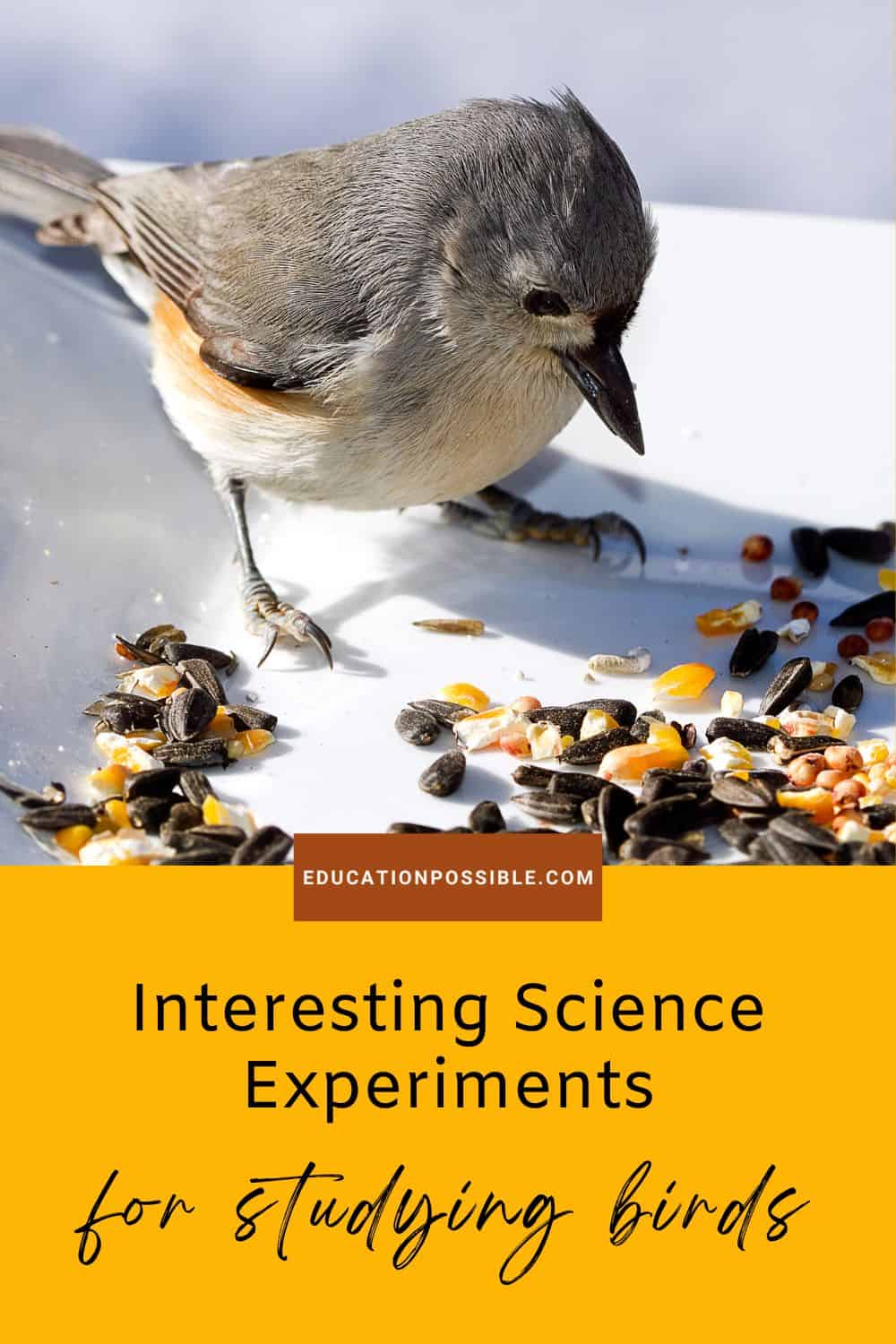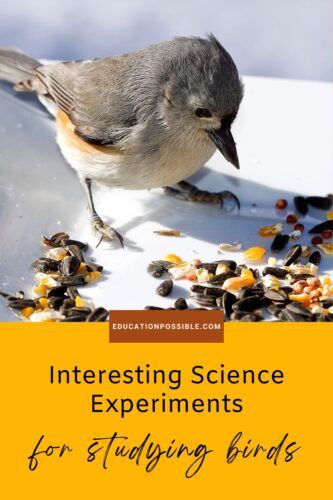Interesting Bird Experiments for Middle School Science
These engaging bird experiments are a fun way to teach your tweens about birds.
There are many science experiments you can add to your middle school lesson plans. Kids will love observing, taking notes about, and recording data on birds.
Keep reading for some great bird-related projects that are perfect for middle school students. They cover a variety of topics, from bird migration to avian flight. So get ready to learn some amazing facts about our feathered friends!

Any links in this post may be affiliate links. See my disclosure statement.
The Science of Studying Birds
Birds are interesting creatures and make great subjects for a middle school science class. The science of studying birds is a branch of zoology, called ornithology.
There are quite a few reasons birds should be a part of a middle school science class. First, they are relatively easy to observe and identify. With a little practice, anyone can learn to recognize common bird species.
Second, we find birds all over the world, so they provide a great opportunity for tweens to learn about unique ecosystems and the importance of conservation.
Third, birds can teach a variety of scientific concepts, such as the principles of flight, migration, and habitat requirements.
Kids will not only learn all kinds of things in science class during a bird study, they’ll also have a ton of fun performing these experiments!
Bird Observation
While not a specific experiment, one of the most important things kids can do during a bird study is to observe as many birds as possible. This will give them experience in scientific observation.
The best place to start is your own backyard. To do this, tweens need to make time in their schedule for bird watching. They can go on nature hikes, walk around the block, or sit in the backyard.
They’ll get to see which birds are in your area and discover what makes each one unique. By taking the time to watch and learn about the birds in your neighborhood, kids will gain a better understanding of these flying creatures.
Take Notes About Each Bird
As a part of your bird lessons, tweens should keep scientific records on the birds they see each day. These bird watching worksheets are perfect for this task.
If you don’t want to use these, have your kids use their science notebook to record things like:
- Unique markings on the birds
- The type of behavior the bird displays – singing, fighting with another bird, picking at something on the ground, etc.
- What types of seeds, insects, nuts, fruit or other foods they’re eating and how often they eat them
- Where exactly in your yard the bird is most likely to be found and what type of surrounding habitat might affect its movement (bushes that give cover, open spaces for flying)
Make sure your kids keep detailed notes and use their critical thinking skills for their scientific recording. For example: “I’ve noticed that the blue jays visit every morning around 9am after I spread sunflower seeds on my deck.”
Now that they’ve noticed the birds around them, it’s time to perform some experiments to take the learning even further.
Bird Experiments
You can use these science experiments during your lessons on birds. You can easily do them at home, making them perfect for homeschoolers. Make sure your tweens are thinking like a scientist, writing what they think, know, and observe.
Testing Different Types of Birdseed
Buy different birdseed and see which one the birds prefer. Try to figure out why. Make sure you’re keeping everything but the seed type consistent, meaning it’s going out at the same time each day, being placed in the same location, etc. Create a chart to record your findings.
Try to determine whether it’s just the seed they’re interested in or if the location or feeder has anything to do with the birds’ preference.
Owl Pellet
An interesting experiment to do during a study on birds is the dissection of an owl pellet. Kids get a kick out of pulling apart the material to see what bones lie inside. After they separate out the bones, have your tweens try to put them together into a full skeleton.
They can use the bones left behind to figure out the animals the bird ate and maybe what type of bird the pellet came from.
Dissecting an Egg
A fun and harmless bird science experiment is to dissect an egg. You can use regular eggs from the store for this science activity. Check out this video on how to dissect an egg. It’s fascinating for kids of all ages.
Bird Flight
As part of your study on a bird’s wings and how they help them fly, spend some time building paper airplanes to test out your theories about flight. See how an airplane’s weight and shape affects how high and far it will fly. How does that relate to a bird’s wings?
What exactly does a bird need in order to fly? Can you replicate that with your paper airplane? Think about things like thrust, drag, and lift.
Bird Migration
This experiment will help students answer questions about migration and determine whether air temperature plays a role in this pattern. Tweens will work with data sets and a spreadsheet to track migration.
You can get all the details for completing the migration experiment, including step-by-step instructions from Science Buddies.
What Colors are Birds Attracted To
In this experiment, kids will determine whether the color of a bird feeder attracts birds. To do this, you’ll need 3-5 identical bird feeders you can paint. These flower shaped feeders should work well.
Kids should choose a different color of paint to paint each feeder. Choose a mix of warm and cool colors (red, green, orange, blue, etc.).
Once they’re completely dry, hang them in your yard (in similar spaces) and fill them with the same kind and amount of bird food at the same time each day. These are the constants in your experiment, so make sure they remain the same.
Then, observe and track visits to each feeder. What can you determine by the number of birds that visit each one?
This is a project that will get kids thinking deeper about a bird’s sight and whether their preferences make a difference.

As you can see, there are plenty of experiments you can do as a part of a middle school bird study. Kids will love the hands-on aspect of the projects and they’ll gain valuable knowledge as they complete them. That’s why any science unit on birds should definitely contain experiments like these.
Helpful Bird Resources
Here are some things you might find helpful to have around during your study of birds.
- How Birds Work – an Illustrated Guide
- Birding Essentials
- Bird Trivia Book
- Jumbo Owl Pellet
How Birds Work: An Illustrated Guide National Geographic Birding Essentials
National Geographic Birding Essentials The Ultimate Bird Trivia Book
The Ultimate Bird Trivia Book Jumbo Barn Owl Pellet Kit
Jumbo Barn Owl Pellet Kit
More Ideas for Learning About Birds
Aside from experiments, here are some activities you can add to your bird lesson plans.
- Fun bird activities for tweens
- Ideas for teaching kids about birds
- This beautiful birds nature study will make planning easy for you
- A bird unit study is a great way to teach kids about birds





